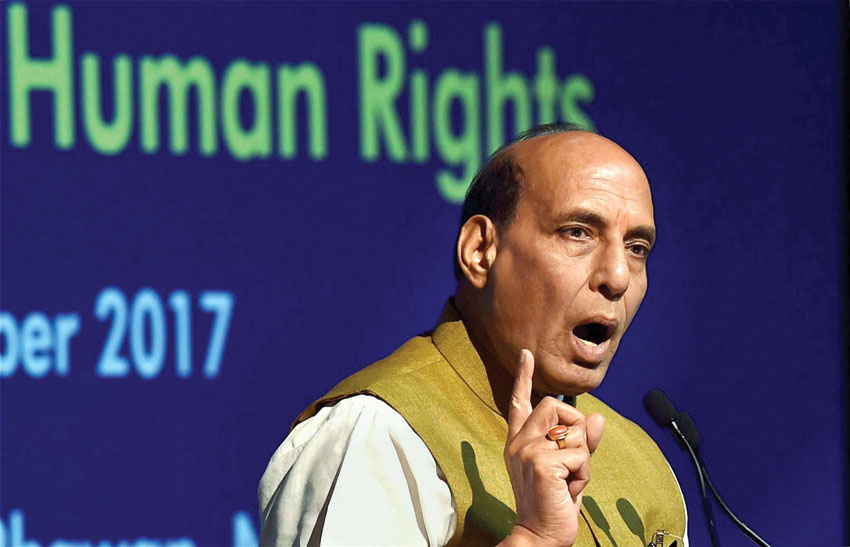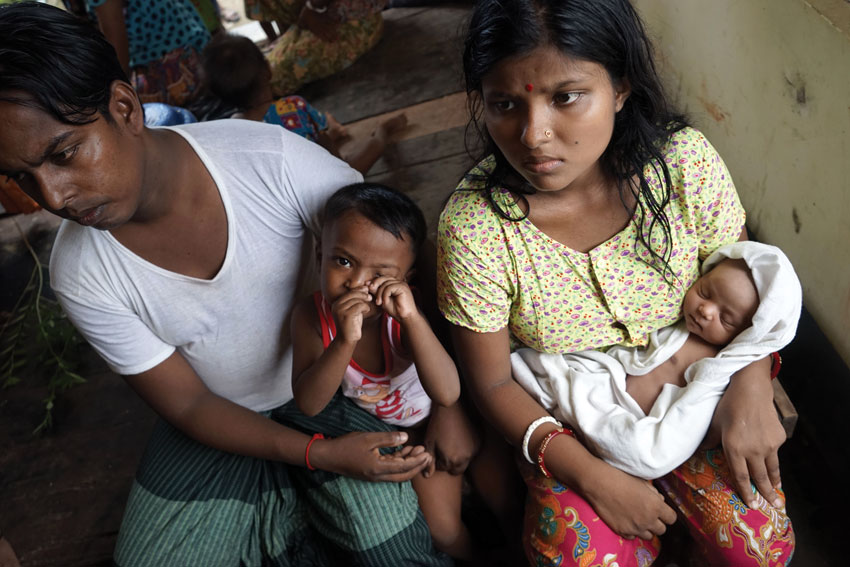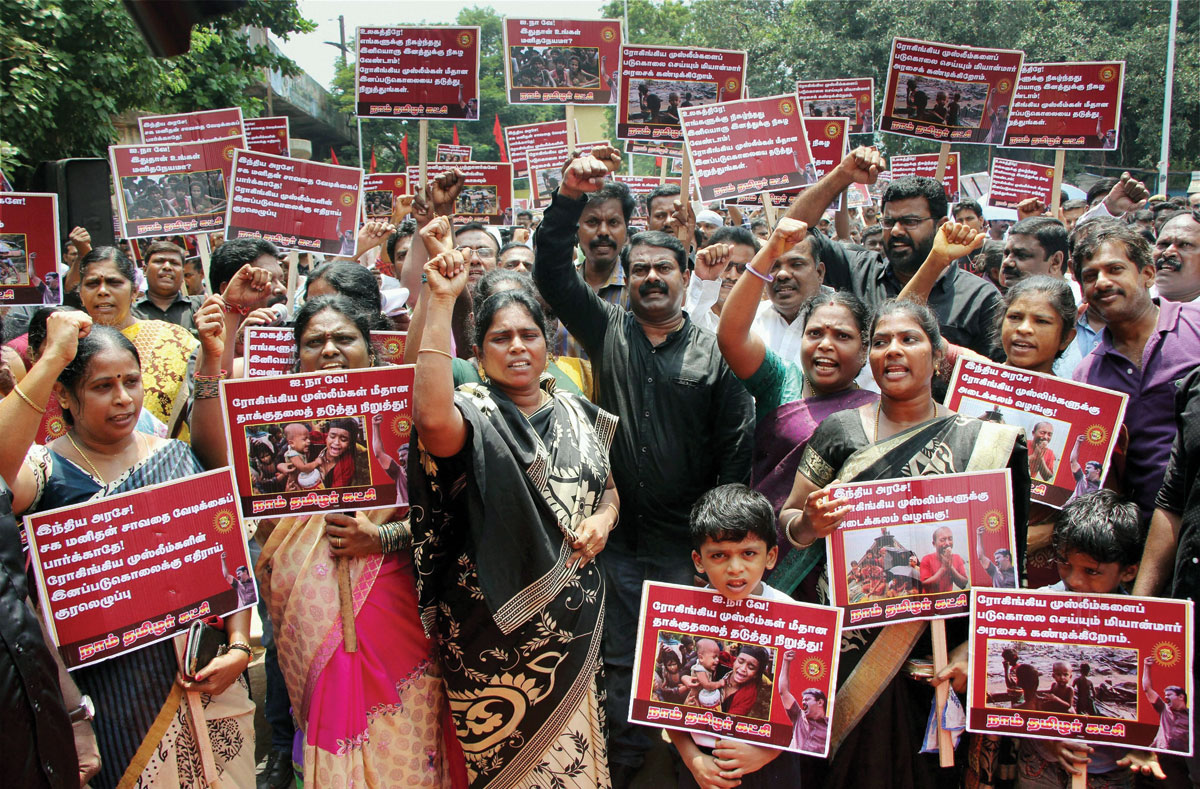Rohingyas, Illegal Immigrants, Not Refugees: Rajnath
Naam Tamilar Katchi chief Seeman along with supporters at a protest seeking to safeguard Rohingya Muslims and condemning the action by Myanmar government in Chennai, Sept. 23. (Press Trust of India)
Indian Home Minister Rajnath Singh said, Sept. 21, Rohingyas are not refugees who have applied for asylum in India but illegal immigrants who “will be deported,” writes Priyanka Bhardwaj.
The Government of India (GoI) is averse to allowing entry of the Rohingya migrants from Myanmar into the Indian territory.
Stating the Center’s position, Union Home Minister Rajnath Singh said, “Rohingyas who have entered India from Myanmar should not be mistaken as refugees because they are “illegal immigrants” who need to be sent back due to national security reasons…They have not sought asylum. In order to get the refugee status, one needs to follow a certain process. None among them has followed that procedure.”
To effect this, New Delhi has instructed the Border Security Force (BSF) to coordinate with other agencies to identify and push back any fresh influx of Rohingyas along the semi-porous 2,217 kilometers along India-Bangladesh border.

However, the border remains infested with middlemen and touts who facilitate infiltration with the help of fake voter identity cards or Bangladeshi identity papers.
Acknowledging these challenges, P.S.R. Anajaneyulu, IG, BSF (South Bengal) says, “They are hard to identify. The few papers that they do carry are of Bangladesh. From Myanmar, they pass through Bangladesh to try and enter India.”
Despite all hurdles, Minister of State for Home Affairs Kiren Rijju confirms the GoI’s intent to deport 40,000 Rohingyas illegally living in the country, citing the reasons of national security which stands to get compromised in the eventuality of terror outfits infiltrating camps of displaced people.
What has further set off alarm bells is that the mastermind of the 26/11 Mumbai terror attack, Hafeez Saeed recently urged Myanmar fleeing Rohingya Muslims to join jihad, and a video of Lashkar-e-Toiba and Jamaat-Ud-dawah Chief calling on Rohingyas to wage “’holy war” if they are threatened surfaced on social networking sites.
Among those expressing solidarity with the Rohingya cause are Zakir Musa, the self-styled commander of Al Qaeda affiliate, Ansar Ghazwat-Ul-Hind and various Kashmiri separatists and religious organizations such as Mutahida Majlis-e-Ulma, headed by separatist Mirwaiz Umar Farooq that are political fronts of terror networks that indulged in ethnic cleansing of Kashmiri Pandits from the Kashmir Valley.
In this backdrop, it is not a coincidence that more than 40,000 Rohingya Muslims have illegally settled in a sensitive Hindu-majority border town already facing the brunt of a demographic invasion from north of Pir Panjal and ISI-sponsored jihadi terror.
These and many more evidences of jihadi links of the Rohingyas leave no doubt that India cannot afford to allow the sinister design of Pakistan’s Inter Services Intelligence which is to spread fundamentalism in areas Rohingyas settle and then foment political and religious clashes to force further exodus of Hindus to alter the regional demography to succeed.
Years ago, Al Qaeda founder Osama bin Laden, in an interview to a Karachi-based newspaper, Ummat, had referred to existence of a strong jihadi force existed in Burma (erstwhile name of Myanmar).
Among the prominent Rohingya jihadists are Ataullah (alias Ameer Abu Amar, Abu Amar Jununi), reportedly the Emir of Arakan Rohingya Salvation Army that carries out attacks on Myanmar’s border outposts; and, Abdus Qadoos Burmi, chief of the Harkat-ul-Jihad-al-Islami Arakan that has close links with the Lashkar-e-Toiba, Jamaat-ud-Dawa and Jaish-e- Mohammed, all ISI-sponsored jihadi terrorist organizations and funded by Saudi petrodollars.
Harakat-ul-Yaqeenis the main Rohingya terror outfit with its leaders of Rohingya origin based in Saudi Arabia and it is well connected in Bangladesh and Pakistan.
Operatives from these terrorist organizations reportedly train and arm terrorists in refugee camps in Bangladesh, Thailand and Myanmar and the possibility of them being active in India too cannot be negated.
On India’s eastern front affiliations of the Muslim migrants with the Bangladesh-based militant outfits such as Bangladesh Islami Chhatrashibir, wing of the Bangladesh Jamaat-e-Islami has compelled the Bangladesh government to turn towards India for advice and help in thwarting this threat of terrorism and infiltration by Rohingyas into its borders, besides the aid that it is already receiving from New Delhi.
The current crisis of August 25 is the latest chapter in the history of Rohingya led insurgency in Myanmar that peaked in the 1940s when they sided with the British against the Japanese troops that had the sympathy of the majority Buddhist population.
Rohingyas who identify themselves as descendants of Sunni Arab traders who settled in northernmost areas of Rakhine province of Myanmar many centuries ago had attempted in vain to carve a breakaway Muslim state by calling upon Mohammad Ali Jinnah the founder of Pakistan to accept its merger with East Pakistan.
Understandably this infuriated the rest of the country and any further provocations by the Rohingyas, by way of atrocities against the local peace-loving Buddhists, had resulted in violent clashes between the two communities.
In the 1960s when the Myanmar army came into power, severe crackdowns on Rohingyas left them with no option but to flee to Bangladesh and other Islamic countries that too were reluctant to host them.
Finally in 1982 the Rohingyas lost their nationhood and all social and political rights.
On Aug. 25, when Rohingya militants led a series of attacks on Buddhists the security forces and allied mobs retaliated by burning down thousands of Rohingya homes.
For the Head of Myanmar, Aung Sun Suu Kyi, a Nobel Peace Prize winner and known for her relentless faith in principles, it has not been a cakewalk to appease the majority population while maintaining a humanitarian stance with the minority Rohingya Muslims.
Especially so when the army controls the internal security, defense and border affairs, 25 percent of seats in parliament and one vice president, it has vastly curtailed her absolute position and her silence and caution are the only means for her survival but also to keep the democratic apparatus alive.
Even as the Western world, China and Russia are not willing to open their doors to more refugees they have been impressing the Myanmarese government to take back Rohingya asylum seekers, end the army-led violent reprisal and not allow the situation to escalate into a kind of sectarian or religious conflict engulfing the Middle East and South Asia where militants like Islamic State and al Qaeda have gained a foothold.
In this context, India, that is a super power in Asia, has been burdened by the influx of these potentially dangerous illegal migrants and even in the presence of evidences that threaten security in the region the UNHCR and the Amnesty International have been pressurizing India to reconsider its decision stating that the Rohingyas are “the most persecuted ethnic group in the world.”
Surprisingly India has no specific refugee law till date despite having handled the largest influx of refugees ever in history of mankind during its Independence in 1947 and it is also not a signatory of the 1951 UN Convention or the 1967 Protocol – both relating to the Status of Refugees and included in the UNHCR statute.
This, therefore, saves India from biding by any such rulings of the UNHCR that may contravene its own interests.
Yet the country remains ideologically split and the Center’s decision to deport Rohingyas has been challenged in the Supreme Court by many eminent lawyers.
What India may do well to heed its bitter experience of settling Buddhist Chakma and Hindu Hajong refugees from Bangladesh in Arunachal Pradesh that has led to complete demographic alteration of social fabric and stretching of limited resources resulting in flare ups with the indigenous population.
Another case for learning would also be the 14th century story of Shah Mir, a failed usurper of power in Swat (in Central Asia), who fled to seek shelter in Kashmir but then repeated the same treachery to gain hold of Kashmir and went on to initiate the forceful Islamization of the state that has witnessed seven exoduses of Kashmiri Pandits till date.
– Priyanka Bhardwaj

Hindus Recount Massacre in Myanmar as Mass Graves Unearthed
Rika Dhar watched as her husband, two brothers and countless neighbors were brutally hacked to death with machetes by masked men who stormed their Hindu village in western Myanmar and frog-marched the terrified inhabitants to the hills.
“After the killing, they dug three large pits and threw them inside. Their hands were still tied behind them and their eyes blindfolded,” said 25-year-old Dhar in a Hindu camp inside Bangladesh where she fled with her two children.
Eyewitnesses told AFP the bloodshed occurred outside their small Hindu village in Kha Maung Seik in northern Rakhine state, where Myanmar authorities have exhumed 45 corpses from mass graves since Sept. 24.
The army says the grim discoveries are evidence of a massacre by Muslim Rohingya militants, Aug. 25, the same day the insurgents launched coordinated raids on police posts that unleashed a surge of communal bloodshed.
The military’s sweeping reprisal has left hundreds dead and sent nearly half a million Rohingya refugees fleeing to Bangladesh, where they have described a campaign of army-led violence the UN says amounts to ethnic cleansing.
Myanmar’s army has rebuffed the accusation and defended its operation as a proportionate crackdown on the Rohingya “extremist terrorists,” while highlighting the plight of other groups, such as Buddhists and Hindus, swept up in the unrest.
On Sept. 27, the army lifted its tight net over the conflict zone to fly reporters to the area in northern Rakhine where the mass graves of Hindus, including many women and children, were exhumed earlier in the week.
It is the first time the military has organized a press trip to the area, where media restrictions have made it difficult to verify a whirlwind of accusations over who is driving the violence.
Displaced Hindus in Bangladesh and Myanmar, unable to contact their families, fear the worst as search efforts continued, Sept. 27, for around 50 other villagers.
Witnesses from Kha Maung Seik, known locally as Fwaira Bazar, said black-clad attackers stormed their community on the morning of Aug. 25, beating and binding the men before driving everyone into the forest.
“After they took us to the hills, they butchered everyone. I saw it with my own eyes,” said Promila Sheel, 15, at a small Hindu village in Cox’s Bazar near the sprawling Rohingya camps.
She said more than 100 people were killed – including her husband and three other family members. The corpses were unceremoniously dumped in freshly-dug pits, Sheel added.
The latest convulsion of violence has deepened already bitter hatreds between various ethnic groups in Rakhine, where tensions have simmered for years.
The women who survived the massacre did not identify the masked attackers as Muslim militants, but said they were targeted because they were Hindus.
Rohingya sympathetic to the militant cause reject allegations their fighters were responsible for massacring civilians.
In a tent near Kutupalong refugee camp, an alleged Rohingya militant flanked by supporters accused Buddhist mobs of carrying out the attacks and pinning the blame on the fledgling Muslim movement.
“They are just trying to tarnish our image,” said the man, requesting anonymity to protect his identity from Bangladesh authorities.
“We never give the moghs (ethnic Rakhine Buddhists) or the non-Muslims a hard time without any valid reason. They are lying to make us look like the bad guys.”
But that brings little solace to Modhuram Pal, a Hindu who has not heard from anyone in Kha Maung Seik since escaping with his family to Bangladesh weeks ago.
“I don’t know the whereabouts of my relatives and friends in Fwaira Bazar,” the 35-year-old told AFP, using the Rohingya name for the village area.
“I heard about the bodies found in the village. God forbid, maybe some of my relatives are in there too.”
– AFP


